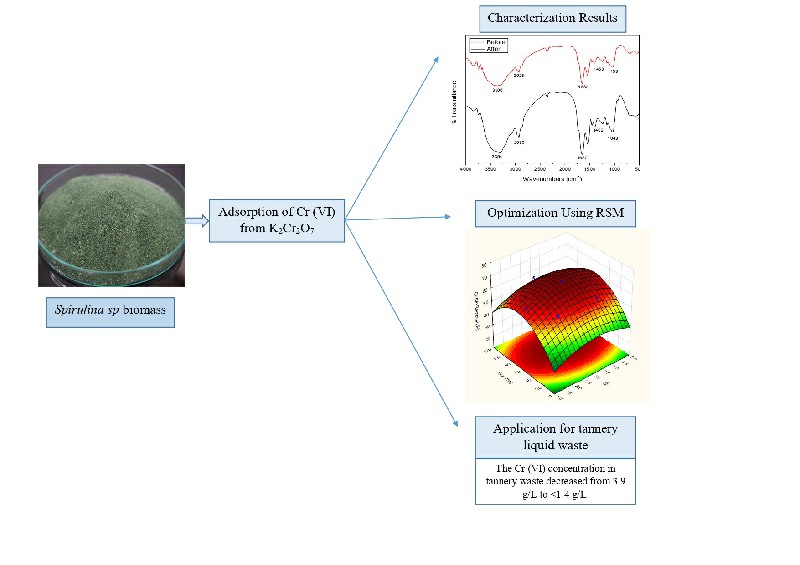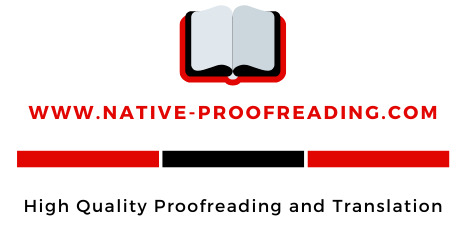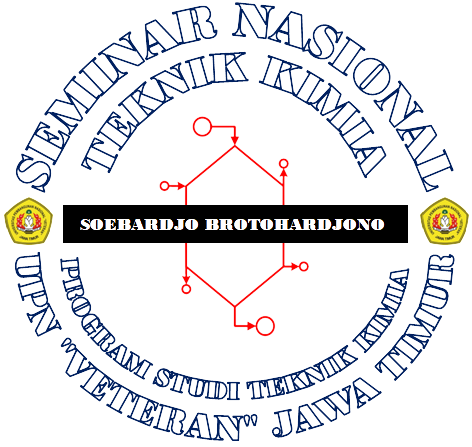
Optimization of Chromium (VI) Adsorption using Microalgae Biomass (Spirulina sp.) and its Application in Leather Tannery Waste
Abstract
This study was conducted to examine the adsorption of Cr (VI) metal using Spirulina sp (inactive) biomass and its application in leather tannery wastewater. The treatment was carried out to determine the influence of independent variables on Cr (VI) adsorption with variations in pH, contact time, and metal solution concentration. The values of the solution pH, adsorption time, and concentration of the best metal solution were used to determine the center points of the optimization variables through Response Surface Methodology (RSM). The results showed that based on the FTIR test, macromolecules present in Spirulina sp biomass included amino, carboxylate, and hydroxy groups. The combination of factor variables that produced the optimum response was at pH 3.165, contact time of 66.58 minutes, and Cr (VI) metal ion solution concentration of 22.9 mg/L, resulting in a Cr (VI) adsorption efficiency of 69.66%. The adsorption pattern was included in the Freundlich adsorption isotherm, and the application of Spirulina sp biomass adsorbent to tannery waste reduced the concentration of Cr (VI) from 3.9 g/L to an undetectable level at <1.4 g/L.
Keywords
Full Text:
DOWNLOAD PDFReferences
Kuncoro, Y. M., & Soedjono, E. S. (2022). Studi Pustaka: Teknologi Pengolahan Air Limbah pada Industri Penyamakan Kulit. Jurnal Teknik ITS, 11(3). doi: 10.12962/j23373539.v11i3.99654
Astuti, D., Sukmawati, N., Asyfiradayati, R., & Darnoto, S. (2022). Kajian Literatur Tentang Reduksi Kromium dalam Air Limbah Penyamakan Kulit dengan Fitoremediasi. Syntax Literate ; Jurnal Ilmiah Indonesia, 7(1), 146. doi: 10.36418/syntax-literate.v7i1.5723
Endah, T., Buhani, & Suharso. (2015). Immobilization of cocodust biomass with silica gel as adsorbent for Cd ( II ) and Pb ( II ) ions in solution. In Proceeding of the IConSSE FSM SWCU (pp. 56–60).
Pradhan, D., Sukla, L. B., Mishra, B. B., & Devi, N. (2019). Biosorption for removal of hexavalent chromium using microalgae Scenedesmus sp. Journal of Cleaner Production, 209, 617–629. doi: 10.1016/j.jclepro.2018.10.288
Rezaei, H. (2016). Biosorption of chromium by using Spirulina sp. Arabian Journal of Chemistry, 9(6), 846–853. doi: 10.1016/j.arabjc.2013.11.008
Katircioǧlu, H., Aslim, B., & Tunçeli, A. (2012). Chromium (VI) biosorption from aqueous solutions by free and immobilized biomass of Oscillatoria sp. H1 isolated from freshwater. ISIJ International, 52(7), 1173–1178. doi: 10.2355/isijinternational.52.1173
Gunasundari, & Kumar, S. (2017). Adsorption isotherm, kinetics, and thermodynamic analysis of Cu(II) ions onto the dried algal biomass (Spirulina platensis). Journal of Industrial and Engineering Chemistry, 56(Ii), 129–144. doi: 10.1016/j.jiec.2017.07.005
Balaji, S., Kalaivani, T., Rajasekaran, C., Shalini, M., Vinodhini, S., Priyadharshini, S. S., & Vidya, A. G. (2015). Removal of heavy metals from tannery effluents of Ambur industrial area, Tamilnadu by Arthrospira (Spirulina) platensis. Environmental Monitoring and Assessment, 187(6), 1–10. doi: 10.1007/s10661-015-4440-7
Radojkovic, M., Zekovic, Z., Jokic, S., & Vidovic, S. (2012). Determination of optimal extraction parameters of mulberry leaves using Response Surface Methodology (RSM) Received. Romanian Biotechnological Letters, 17(3), 7295–7308.
Nurmiah, S., Syarief, R., Sukarno, S., Peranginangin, R., & Nurmata, B. (2013). Aplikasi Response Surface Methodology Pada Optimalisasi Kondisi Proses Pengolahan Alkali Treated Cottonii (ATC). Jurnal Pascapanen dan Bioteknologi Kelautan dan Perikanan, 8(1), 9. doi: 10.15578/jpbkp.v8i1.49
Adetya, N. P., Arifin, U. F., & Anggriyani, E. (2021). The removal of chromium (VI) from tannery waste using Spirulina sp. immobilized silica gel. Turkish Journal of Chemistry, 45(6), 1854–1864. doi: 10.3906/kim-2106-22
Hevira, L., & Gampito. (2022). The Kinetic Analysis and Adsorption Isotherm of Chicken Egg Shells and Membranes Against Synthetic Dyes. Jurnal Riset Teknologi Pencegahan Pencemaran Industri, 13(2), 28–36. doi: 10.21771/jrtppi.2022.v13.no2.p28-36
Kusworo, T. D., Puji Utomo, D., Rahmatya Gerhana, A., & Angga Putra, H. (2018). Process Parameters Optimization in Membrane Fabrication for Produced Water Treatment Using Response Surface Methodology (RSM) and Central Composite Design (CCD). Reaktor, 18(1), 7. doi: 10.14710/reaktor.18.1.7-15
Bayuo, J., Abukari, M. A., & Pelig-Ba, K. B. (2020). Optimization using central composite design (CCD) of response surface methodology (RSM) for biosorption of hexavalent chromium from aqueous media. Applied Water Science, 10(6), 1–12. doi: 10.1007/s13201-020-01213-3
Nuvitasari, R., Rohman, A., & Martono, S. (2019). Response surface methodology used in the optimization of RP-HPLC condition for separation of carmine and rhodamine B. Indonesian Journal of Pharmacy, 30(4), 276–284. doi: 10.14499/indonesianjpharm30iss4pp276
Tavares, L., & Noreña, C. P. Z. (2021). Characterization of the physicochemical, structural, and thermodynamic properties of encapsulated garlic extract in multilayer wall materials. Powder Technology, 378, 388–399. doi: 10.1016/j.powtec.2020.10.009
Tao, Y., Wu, Y., Yang, J., Jiang, N., Wang, Q., Chu, D. T., … Zhou, J. (2018). Thermodynamic sorption properties, water plasticizing effect, and particle characteristics of blueberry powders produced from juices, fruits, and pomaces. Powder Technology, 323, 208–218. doi: 10.1016/j.powtec.2017.09.033
Mokone, J. G., Tutu, H., Chimuka, L., & Cukrowska, E. M. (2018). Optimization and Characterization of Cladophora sp. Alga Immobilized in Alginate Beads and Silica Gel for the Biosorption of Mercury from Aqueous Solutions. Water, Air, and Soil Pollution, 229(7). doi: 10.1007/s11270-018-3859-1
Sathvika, T., Manasi, Rajesh, V., & Rajesh, N. (2016). Adsorption of chromium supported with various column modeling studies through the synergistic influence of Aspergillus and cellulose. Journal of Environmental Chemical Engineering, 4(3), 3193–3204. doi: 10.1016/j.jece.2016.06.027
Sibi, G. (2016). Biosorption of chromium from electroplating and galvanizing industrial effluents under extreme conditions using Chlorella vulgaris. Green Energy and Environment, 1(2), 172–177. doi: 10.1016/j.gee.2016.08.002
Li, Q., Huang, Q., Pan, X. Y., Yu, H., & Zhao, Z. T. (2022). Adsorption behavior of Cr(VI) by biomass-based adsorbent functionalized with deep eutectic solvents (DESs). BMC Chemistry, 16(1), 1–14. doi: 10.1186/s13065-022-00834-w
Kumar, M., Singh, A. K., & Sikandar, M. (2020). Biosorption of Hg (II) from aqueous solution using algal biomass: kinetics and isotherm studies. Heliyon, 6(1), 1–32. doi: 10.1016/j.heliyon.2020.e03321
Dakhil, I. H., Naser, G. F., & Ali, A. H. (2021). Response Surface Modeling of Arsenic Adsorption by Modified Spent Tea Leaves. IOP Conference Series: Materials Science and Engineering, 1090(1), 012129. doi: 10.1088/1757-899x/1090/1/012129
De Schepper, W., Vanschepdael, C., Huynh, H., & Helsen, J. (2020). Membrane capacitive deionization for cooling water intake reduction in thermal power plants: Lab to pilot scale evaluation. Energies, 13(6). doi: 10.3390/en13061305
El-Mekkawi, S. A., Abdelghaffar, R. A., Abdelghaffar, F., & El-Enin, S. A. A. (2021). Application of response surface methodology for color removal from dyeing effluent using de-oiled activated algal biomass. Bulletin of the National Research Centre, 45(1). doi: 10.1186/s42269-021-00542-w
Ahmad, S., Pathak, V. V., Kothari, R., Kumar, A., & Naidu Krishna, S. B. (2018). Optimization of nutrient stress using C. pyrenoidosa for lipid and biodiesel production in integration with remediation in dairy industry wastewater using response surface methodology. 3 Biotech, 8(8), 0. doi: 10.1007/s13205-018-1342-8
Iqbal, M., Iqbal, N., Bhatti, I. A., Ahmad, N., & Zahid, M. (2016). Response surface methodology application in optimization of cadmium adsorption by shoe waste: A good option of waste mitigation by waste. Ecological Engineering, 88, 265–275. doi: 10.1016/j.ecoleng.2015.12.041
Hadiyanto, S. H. (2016). Response surface optimization of ultrasound-assisted extraction (UAE) of phycocyanin from microalgae Spirulina platensis. Emirates Journal of Food and Agriculture, 28(4), 227–234. doi: 10.9755/ejfa.2015-05-193
Ardila, L., Godoy, R., & Montenegro, L. (2017). Sorption Capacity Measurement of Chlorella Vulgaris and Scenedesmus Acutus to Remove Chromium from Tannery Waste Water. IOP Conference Series: Earth and Environmental Science, 83(1). doi: 10.1088/1755-1315/83/1/012031
Article Metrics
Abstract has been read : 127 timesDOWNLOAD PDF file viewed/downloaded: 0 times
DOI: http://doi.org/10.25273/cheesa.v6i2.16315.105-117
Refbacks
- There are currently no refbacks.

This work is licensed under a Creative Commons Attribution-NonCommercial-ShareAlike 4.0 International License.



